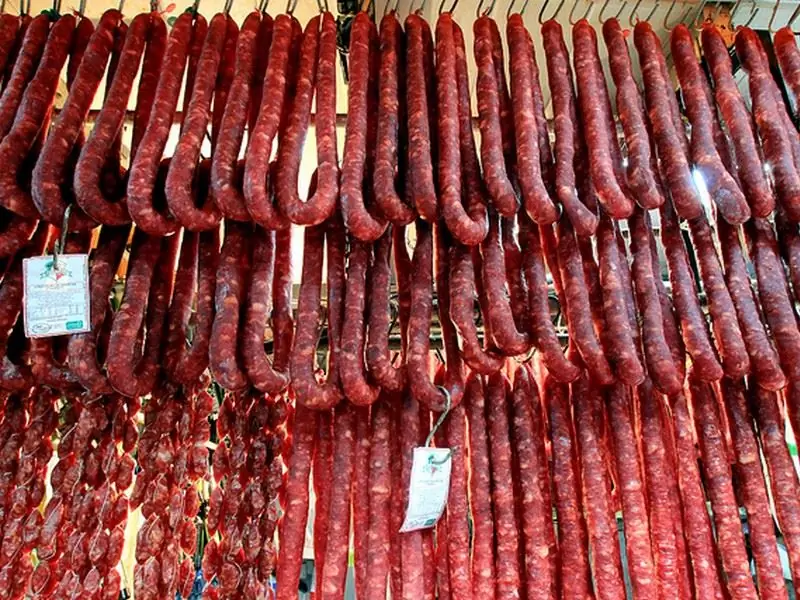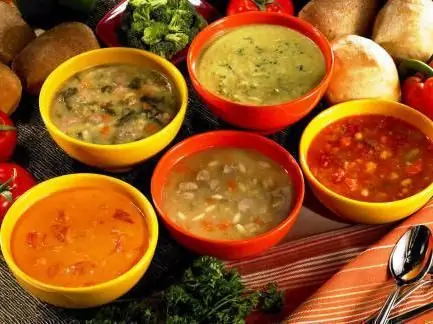2025 Author: Isabella Gilson | [email protected]. Last modified: 2025-01-23 12:50:36
Soups, according to our long tradition, are indispensable during lunch time. They are usually served after cold dishes and snacks. They contain substances that enhance digestive secretion, preparing the body for the absorption of food.
Soups: classification
These are liquid dishes based on decoctions, broths, bread kvass or milk. In addition, they contain a dense part - these are cereals, side dishes, pasta, fish, meat, poultry and other products.

Their main purpose is to stimulate appetite. Soups have two ingredients that make you feel hungry:
- Aromatic and flavoring substances.
- Chemical irritants of digestive activity.
Aromas are given by spices, roots, onions, seasonings that are in the recipe. Yes, and the appearance itself attracts and makes you want to eat.
It should be noted that there are different types of first courses.
Soups, which are classified below, are divided into different groups according to the nature of the liquid base. This subdivision is the most appropriate.
So, what areare there soups? The classification of first courses implies the existence of four broad groups:
- The first is based on broths (bone, meat, bird, fish, mushroom) and decoctions (from vegetables, pasta, beans).
- The second one is with milk.
- Third - on kefir, bread kvass.
- Fourth - on berry and fruit decoctions.
Characteristics of the first group
So, we figured out what soups are. The classification emphasizes the features of each group. And yet, let's talk about each of them in more detail.

It should be noted that the first group is the most extensive. It, in turn, is divided into three subgroups:
1. Filling soups. These include cabbage soup, borscht, s altwort, pickles, stews and potato soups. The preparation of such dishes involves the gradual addition of a variety of products to the broth, which are a side dish. Vegetables enrich such food with vitamins and nutrients, give a unique taste, aroma, form a certain structure. Dressing soups are usually prepared using browned roots and onions.
2. Transparent.
3. Puree.
This is the classification of hot soups. Their peculiarity is that they are served only when they are warm.
Second, third and fourth groups of soups
The second group of soups is prepared only with milk, and therefore served hot. As for the third group, its dishes are consumed only cold.

The fourth is divided into two parts: wiped and not wiped. Such dishes are served cold in spring or summer, and hot in autumn and winter.
Classification of soups (the diagram is given in the article) is quite simple. However, she is not the only one. There are other options for dividing such dishes into groups.
Separation by temperature
What other groups are soups divided into?

Classification by supply temperature implies a division into two subgroups:
- Cold soups. They are perfect for hot summer time. Their basis can be kvass, kefir, whey. These products themselves already speak of the impossibility of heat treatment. For such a soup, both raw ingredients (cucumbers, radishes, onions) and boiled ingredients (beets, potatoes) can be used.
- Hot soups are borscht, pickles, hodgepodge. They are universal, they are prepared on the basis of broth or on water, so they can be served either hot or cooled. The ingredients for this soup are exposed to heat.
- Sweet soups. They can be eaten cold in spring and summer, and hot in winter. The temperature of a cold dish should be no higher than fourteen degrees, and hot - no less than seventy-five.
Classification based on dish
According to the basis that is present in the soup, dishes are divided into: vegetarian, meat, fish, vegetable and mushroom.

Asliquids use milk and milk drinks, broths, decoctions of fruits and vegetables, kvass. And for a side dish they can take mushrooms, vegetables, legumes, cereals, poultry meat, pasta.
Of course, the basis of most soups is the broth. He, in turn, also has his own classification:
- Bone. Veal and beef bones are used for its preparation.
- Meat. For him, they take the brisket, back, hem.
- Fish made from waste and heads.
- Mushroom is made on the basis of dried porcini mushrooms.

Classification of dressing soups
Filling soups are those liquid dishes that we most often use in everyday life. They are divided into:
- Borschi.
- Rassolniki.
- Shi.
- Vegetable soups.
- Potato.
- Cereals.
- Solyanki.
- With pasta.
Borscht are soups that are prepared with the obligatory use of beets. To prepare them, you need bone broth, bird or mushroom. The composition of the products for this dish is very diverse. In addition to beets, onions, carrots, celery, and parsley are also used. Depending on the composition, they put beans, potatoes, peppers, etc.
Schi is a native Russian dish. They are prepared from sauerkraut or fresh cabbage, spinach, sorrel, young nettle. Bone broth, cereal or vegetable broths are taken as the basis. Sauerkraut must be stewed beforehand, and fresh cabbage is scalded so that it does not taste bitter.

Pickles are cooked with pickles, brine and white root. They can be vegetarian, meat, bone, fish broth with offal, mushroom broth. Pickled cucumbers are poured into a saucepan with water and stewed for fifteen minutes. The potatoes are cut into pieces, onions and roots - into strips. In order for such a soup to have a spicy taste, brine is added to it, which is filtered and boiled.
Solyanka is an old national Russian dish. For its preparation, pickles, onions, tomatoes, olives, olives, capers are used. The basis is fish and meat broths. Cucumbers are cut into cubes and stewed, and the onions are lightly sautéed. Olives are also used in the modern version. The bones are taken out of them and washed. The lemon is cut into slices. The meat is cut into pieces and boiled. Ready-made mushroom and meat hodgepodge is served with sour cream. But they don’t put it in fish sour cream.
As for potato soups, vegetable soups with cereals, their assortment is very diverse. They are cooked on both meat and bone broths, vegetable and mushroom broths. All ingredients are cut into strips, cubes, slices. It is important that all products are uniformly chopped.
For soups with cereals and pasta, flour products, oatmeal, rice, semolina, pearl barley are used. They are cooked on meat broths and mushroom broths.
We see how different classifications can be. The range of soups, in turn, is so large that it is impossible to talk about all types within the framework of the article.
What is soup-puree?
Such a dish must have a homogeneous structure, without lumps and pieces of food. The soup should have the consistency of heavy cream. The color of the dish depends on its ingredients. A distinctive feature is the most delicate taste and uniform structure.
Recently, this dish has become very popular and is served in all cafes and restaurants, but it would be a mistake to believe that this is a modern invention. Puree soups have existed for a long time, it’s just that earlier their preparation was more complicated, but now, with such wonderful equipment as blenders, it is very simple and quick to prepare such a dish. No need to manually grind the ingredients.
Classification of puree soups implies division into cream and puree. Their feature is an unusual consistency, and milk often acts as the basis.
Complex options
Basically, all those soups that we are used to seeing on our table are initially complex dishes. However, at present, their preparation is simplified, since some traditions have been lost. Therefore, they can hardly be called complex.
It must be said that complex soups should be based on several varieties of fish or meat. Unfortunately, such dishes are now prepared extremely rarely, as they say, on special occasions. Most often you can find complex soups in the menu of expensive restaurants.

Classification of complex soups: borscht, soup, cabbage soup, fish soup, stew, puree soup, hodgepodge, pickle. All these varieties of first courses originally implied cooking based on broth.from several varieties of fish and meat. You and I, when preparing all these soups, as a rule, use one variety.
So, for example, we are all used to catering pickles. What can be delicious in it? From its original form, it retained only the use of pickles and at the same time lost much of its taste. Meanwhile, a true pickle - with kidneys, mushrooms, poultry or just vegetables - has a completely different taste and appearance.
Instead of afterword
Soups have been the basis of nutrition since ancient times. And now they occupy an important place in the diet, as they are a source of many vitamins and nutrients. It is not for nothing that nutritionists emphasize the need for the mandatory presence of liquid dishes in the diet, which positively affect the entire system of our digestion.
Recommended:
Types and varieties of sausages: classification, taste characteristics and compliance with GOST requirements

Today there is a huge number of various types and varieties: boiled, raw-smoked and boiled-smoked sausages. They differ not only in the method of processing, but also in the type and composition of raw materials, in the pattern of minced meat on the cut and type of shell, in nutritional value and quality, which, in turn, is determined by the color, taste and smell of the product
What are soups? Types of soups

We cannot imagine our life without soup: hot, thick and rich or light vegetables, cold summer okroshka or fragrant and hot borscht - they have firmly taken their place in our daily diet. In winter they warm and give strength, and in summer they give coolness and freshness. There are all favorite types of soups, but there are also very unusual and exotic ones. But in traditional cooking, all soups are divided into three large groups: hot, cold and sweet
Classification of sweet dishes: description, characteristics, cooking features

Any festive or dinner table often ends with a dessert that brings its own zest and satisfaction after a meal. The assortment and classification of sweet dishes are large and varied not only in Russian, but also in any other cuisine of the countries of the world. Sweets are tasty and incredibly nutritious, thanks to sugar and minerals, and also, depending on the recipe, contain a lot of proteins and fats
Classification of tea according to various parameters. Types, characteristics and producers of tea

There is a wide variety of classifications of tea, and therefore it is necessary to understand a little how to determine the quality of the product. And, of course, you should be guided by your wishes and tastes
Types, characteristics and classification of POP (catering establishments)

POP (catering establishments) are establishments that serve people who want to eat delicious food. Depending on various factors, they are divided into groups. Let us further consider the main features of the POP classification (according to GOST)

